The Diaries of George Fujimoto
George Fujimoto was born in Riverside in 1921. His parents were Issei (first-generation Japanese Americans, emigrants to the U.S. who were born in Japan ). During 1942, when George was 21 years old, he began keeping a diary. These diaries, now in Special Collections at UCR, cover 1942-48 and document historic events from a very personal perspective:
• the Fujimoto family's evacuation from Riverside to Poston, the Japanese American concentration camp in Arizona
• life at Poston
• resettling in Des Moines , Iowa after leaving Poston
• being drafted and trained by the Military Intelligence Service as a translator
• serving in occupied Japan as a military translator
• returning to the Fujimoto family farm in Riverside in 1946
• going to college on the G.I. Bill
The Fujimoto Family and the Japanese American Community in Riverside
George's father, Toranosuke Fujimoto, was born in Wakayama-ken , Japan on July 11, 1882 and emigrated to the U.S. in 1902. He was the second son in his family and, thus unable to inherit the family farm, went to the U.S. in search of work. He received very little formal schooling as a boy but learned to read and write at home. George remembers that he landed in the state of Washington, worked for a time in Orange County in Southern California, and eventually settled in Riverside because he had heard that land there was inexpensive and abundant. He eventually began to use the given name "George" as non-Japanese found "Toranosuke" too difficult to pronounce.
George's mother Suna Fujimoto ( nee Sugi) was born in Miyazaki-ken, Japan , on December 26, 1887. She and her sister were given the choice between a kimono and an education; her sister chose a kimono, but Suna chose an education and was trained as a nurse. Her marriage to Toranosuke Fujimoto was arranged, and she emigrated to the U.S. in 1911.
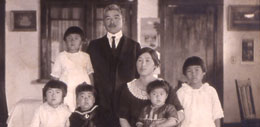
The Fujimoto family, ca. 1928, in their home at 3135 Chase Road in Riverside . Back row, left to right: Mabel Sumiko Fujimoto and George Toranosuke Fujimoto. Front row, left to right: Doris Miyeko Fujimoto, George Fujimoto, Jr., Suna Sugi Fujimoto, Charles Mitsuru Fujimoto, and Lily Yuriko Fujimoto. (Fujimoto family photograph.)
The couple had six children:
| Lily Yuriko Fujimoto (later Taka) | Born August 12, 1916 |
| Doris Miyeko Fujimoto (later Aoki) | Born December 29, 1917 |
| Mabel Sumiko Fujimoto (later Takeda, later Bristol , later Zink) | Born January 27, 1920 |
| George Fujimoto, Jr. | Born January 2, 1921 |
| Charles Mitsuru Fujimoto | Born February 21, 1925 |
| Betty Jean Mom oyo Fujimoto (later Ogawa) | Born August 5, 1931 |
By all accounts, the two were very close; indeed, as a farming couple, they spent virtually all of their time together, whether in the fields or at home.
George refers to other Japanese American families in nearly every diary entry, and this is especially striking in the entries between March and May 1942, before the Fujimotos were evacuated to Poston. At that time, some three hundred Japanese and Japanese Americans lived in Riverside; at the time of this writing (2005), their numbers are much, much smaller, decimated by internment, resettlement, and changes in the local economy of Riverside resulting in the end of small farms as a way of life.
The Fujimotos owned a farm in north Riverside on Chase Road. It was active from 1911 or 1912 to 1967 or so. Toranosuke Fujimoto (George's father) bought the land about a year before Alien Land Law went into effect in 1913. The Fujimotos raised chickens and grew strawberries and walnuts.
The entire family was evacuated to Poston in May 1942, but their troubles began several months before that.
Two Diaries, Same Day: March 11, 1942
George's diaries begin, compellingly, on March 11, 1942, when George's father, along with other Issei men in the Riverside community, was arrested by the FBI and taken off to an undisclosed location, leaving the Fujimoto family in a state of shock. They were not alone in their predicament: within an hour on that day, the FBI closed in on a number of Issei men in Riverside in a closely coordinated operation that headed off the possibility of Japanese American families alerting one another.
The twenty-one-year-old George started a diary on this day for two reasons: he sensed that the events unfolding around his family were historic, and he had seen his father write in his own diary every day, without fail. Toranosuke Fujimoto kept a diary for his entire life. Now in Special Collections at the University of California , Riverside, the diaries cover 1913-1968 and are entirely in Japanese. Toranosuke wrote in a cursive style that was distinctive to his generation and now very difficult for contemporary Japanese to read.
Compare the two entries. Keep in mind that neither writer ever thought anyone else would ever read their account. Notice that George used exactly the same kind of hardbound diary that he knew his father used. Consider the presence of mind exhibited by Toranosuke Fujimoto in packing his diary along with some clothes while surrounded by FBI agents in his home.
Toranosuke Fujimoto, writing in a jail cell. (Translated freely and with difficulty by Yukiko Matsuyama.) "This morning I took care of the chickens and finished breakfast around 8 a.m. Mr. Sakai [illegible]. The FBI came and searched the house, taking lots of things. They gathered some of my clothes and took me to jail. Later, Mr. Sakai was brought to jail as well. [illegible] [ A list of names, presumably other Issei men also brought in: ] Hirokawa, Oyama, Matsubara and his children, Masajiro, Shimono, Tsubota, Ishida and his children, Tanaka. This is the first time I've been in jail. This is a very difficult experience for me. God sent me this experience as a lesson, so I shouldn't complain that this is happening to me. I shouldn't be sad. I should appreciate this precious life that God gave me."
George Fujimoto, writing at home. "Went to school as usual. Shok [his older sister Mabel] at work in packing house. Came home about 5 PM and was shocked to learn that Pop was taken into custody by federal officials today. Twenty-eight Riverside Japanese aliens were rounded up in today's raid; Mr Sanematsu & Pop included. Fortunately Pop was partially prepared."
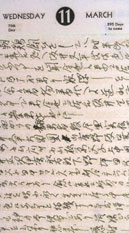 |
 |
All of George Fujimoto's diaries, 1942-48, in Special collections at the University of California, Riverside. (Photos by Steve Walag.)
In the months following, George dropped out of college and took over responsibility for the family farm and then, as it became clear that evacuation was nearing, assumed responsibility for the family's legal matters and material belongings. The details of selling off many of the family's possessions are vivid, as are George's accounts of how Riverside's Japanese American community drew together during those months, sharing information and undergoing complex temporary relocations so that extended families would be evacuated together to the same camps.
The Fujimoto family-George, his sisters Mabel, Lily, and Betty, his brother Charles, and his mother-arrived at Poston on Friday, May 22, 1942. His father Toranosuke arrived on July 7, 1942. He was first held in a special "Justice Department Camp" in Tujunga Canyon, high in the Sierra Madre Mountains above Pasadena, then sent to a similar camp in Santa Fe, New Mexico, and was eventually relocated to Poston.
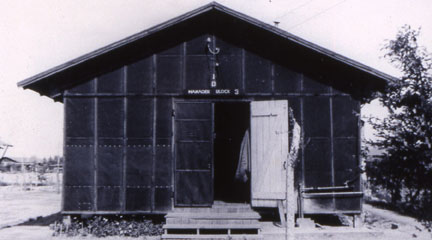
The Fujimoto family's barrack in Poston, Camp I, Block 3, Apartment 4-D, 1943. (Fujimoto family photograph.)

The Fujimoto parents in front of their apartment (Block 3, Building 4, Apt. D) in Poston, Arizona, ca. 1944-45. Left to right: Suna Fujimoto, Mrs. Katano, Mrs. Nagasaki, Toranosuke Fujimoto. (Fujimoto family photograph.)
In 1943, George's older sister Lily, her husband Harrie Taka, and their infant daughter got permission to leave Poston and to resettle in Des Moines, Iowa. George went with them.
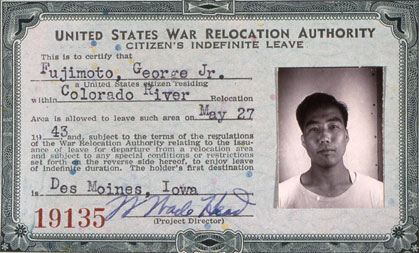
The ID card issued to George Fujimoto in 1943 that gave him permission to leave Poston and move to Des Moines . (Fujimoto family photograph.)
After working in a photography shop in Des Moines for only 8 months, George was drafted. He completed basic training at Fort Blanding , Florida between April and August 1944 and was assigned to Military Intelligence Service Language School (MISLS), where he took intensive language training in Japanese from September 1944 to August 1945. The atomic bombs were dropped on Hiroshima and Nagasaki on August 6 and 9, 1945 and George graduated from MISLS on August 18th. He served in occupied Japan from November 1945 until May 1946, when he was discharged. Before leaving Japan, he visited his parents' families.
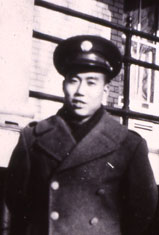 |
 |
(Left) George Fujimoto at Fort Snelling, Minnesota, 1944. (Right) George Fujimoto's mother's sister's family in Miyazaki city. Left to right: George Fujimoto, his cousin Nobutatsu Kodera's son, his aunt, and her nephew Nobutatsu Kodera.
George's mother left Poston in September 1945, when the camp was officially closed. She returned to Riverside and waited until their White neighbors, the Gibsons, vacated the farm. The Gibsons had originally agreed to rent the farm while the Fujimotos were incarcerated, but stopped sending payments after only several months. They left the farm without problem when the Fujimotos returned. George's father was the block manager at Poston and stayed until nearly everyone had left, returning to Riverside some weeks after his wife. George returned to Riverside on June 19, 1946 and immediately went to work on the family farm.

The extended Fujimoto family in the living room in the house on Chase Road, Riverside, ca. 1953. Front row, left to right: Cha Fujimoto, Lily's and Harrie's children Leroy, Beverly, and Ruth. Back row, left to right: Lily Taka, Tina Fujimoto (Cha's wife from Italy ), Betty Jean Fujimoto, Suna Fujimoto (George's mother), Toranosuke Fujimoto (George's father), Harrie Taka, and George Fujimoto. (Fujimoto family photograph.)
George eventually inherited the farm from his father. He ran the ranch until the mid-1960s, got married, raised a family, and acquired adjacent parcels of land in north Riverside. When the poultry business bottomed out, he worked as an insurance salesman from 1967 to 1976 and then bought and managed a small doughnut shop in San Bernardino from 1976 to 1986, when he retired. He and his wife Masako moved to Washington state in 1988, drawn by inexpensive real estate and the region's less crowded conditions. Masako died in March 2005. George still lives in Ferndale , Washington but frequently visits Riverside.
George has spoken in public many times about the Japanese American internment. His life is a testimony to hard work and his commitment to social justice.

George and Masako Fujimoto, 2000.

An undated photograph from a newspaper article, probably The Press-Enterprise, ca. 1980s. (Fujimoto family materials.)

